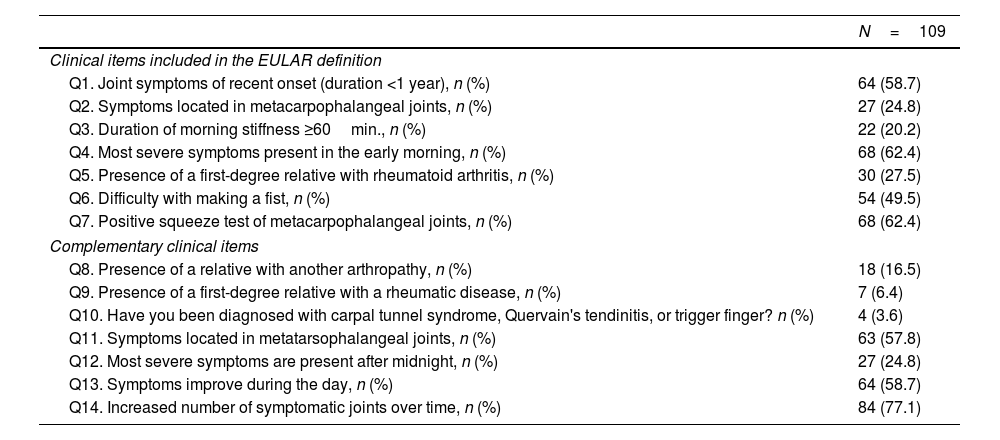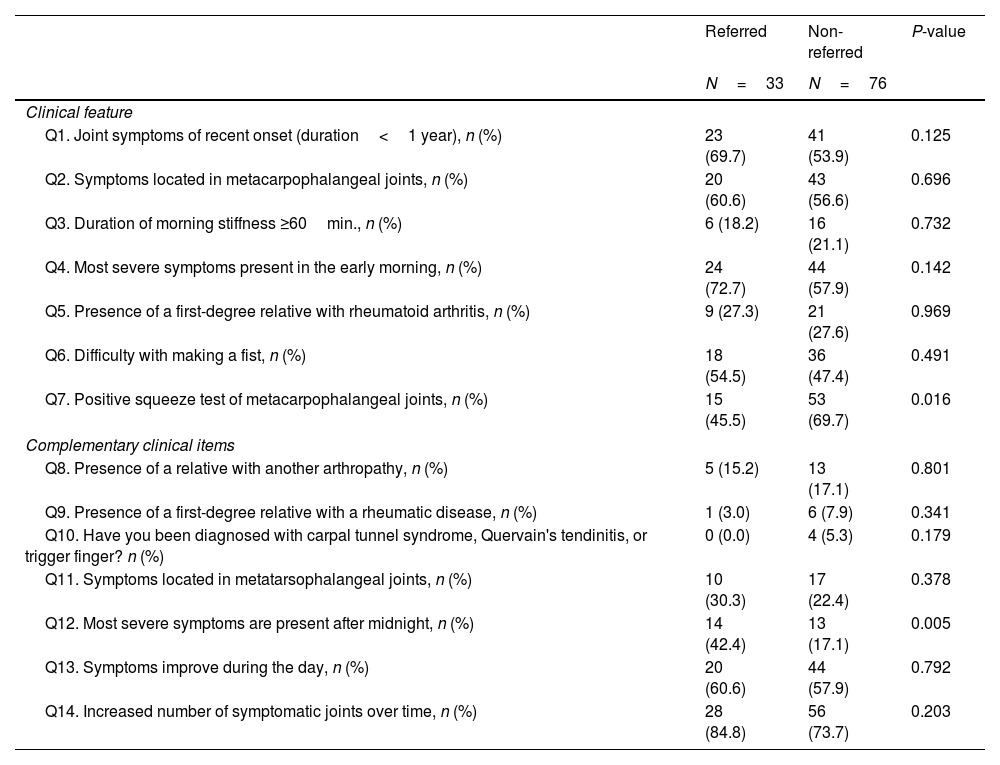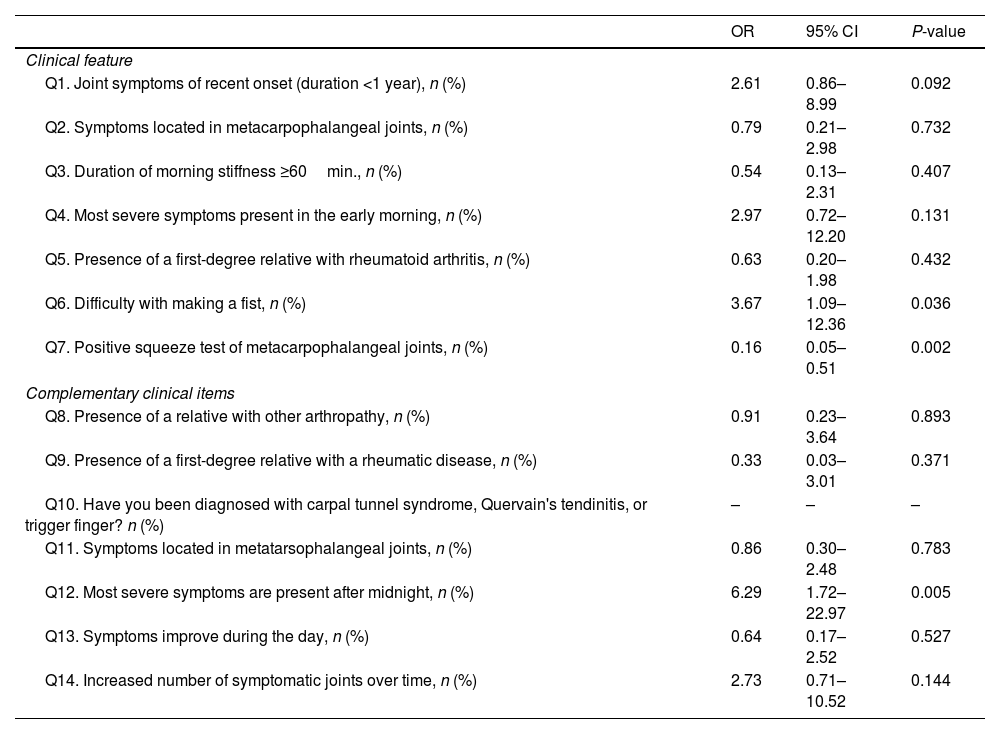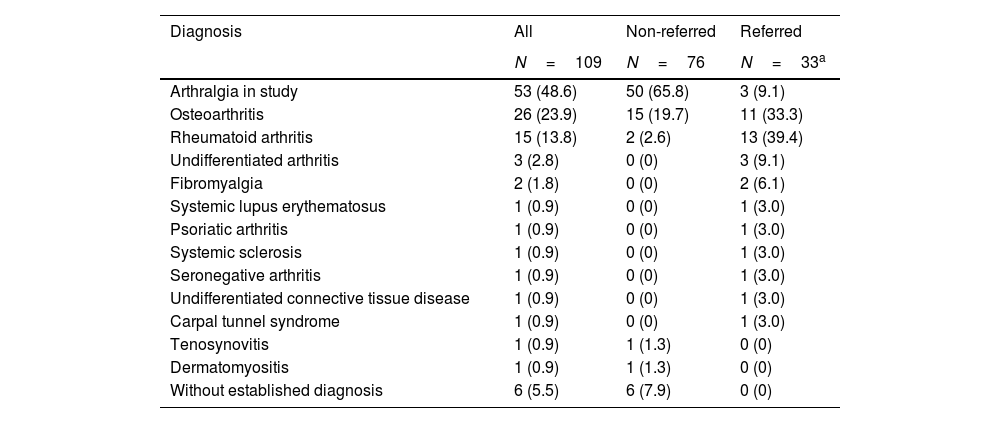Early referral of patients with suspicious of rheumatoid arthritis (RA) has an impact on prognosis. Our study aimed to evaluate the clinical characteristics of patients with hands arthralgia who were referred from primary care physicians (PCP) to the rheumatologist.
MethodsA descriptive, observational, prospective cohort study was performed. We included patients who visited a PCP for the first time for hands arthralgia. Demographics and the European Alliance of Associations for Rheumatology criteria for arthralgia suspicious for progression to RA plus seven complementary questions, the time to referral, the pressure needed to provoke pain with an automatic squeeze test machine in the metacarpophalangeal joints of both hands, and the diagnoses established at the last review of medical charts from patients on follow-up were documented. The primary outcome was the referral to a rheumatologist.
ResultsA total of 109 patients were included. The mean age was 49.9 years, 81.6% were women. 30.3% were referred to the rheumatologist. The time to referral was a median of 38 days. The main clinical characteristics associated with referral to the rheumatologist were the “most severe symptoms are present after midnight” (OR=6.29) and the “difficulty with making a fist” (OR=3.67). An isolated “positive squeeze test of metacarpophalangeal joints” was not associated with a referral to the rheumatologist.
ConclusionsAmong patients with hands arthralgia who attended PCP, those with most severe symptoms after midnight and difficulty making a fist were more likely to be referred to the rheumatology clinic. Isolated positive squeeze tests are not a parameter for referral, it should only be performed if arthralgia is clinically suspected.
Derivar tempranamente a los pacientes con sospecha de artritis reumatoide (AR) tiene un impacto en su pronóstico. Nuestro estudio tuvo como objetivo evaluar las características clínicas de los pacientes con artralgia de manos que fueron remitidos desde médicos de atención primaria (MAP) al reumatólogo.
MétodosSe realizó un estudio de cohorte descriptivo, observacional, y prospectivo. Incluimos pacientes que acudieron con un MAP por artralgia de manos. Se documentaron criterios demográficos y de la European Alliance of Associations for Rheumatology (EULAR) para artralgia con sospecha de progresión a AR más siete preguntas complementarias, el tiempo de derivación, la presión necesaria para provocar dolor con una máquina automática que comprime las articulaciones metacarpofalángicas, y los diagnósticos establecidos en la última revisión documentados en los expedientes médicos de los pacientes en seguimiento. El resultado principal fue la referencia al reumatólogo.
ResultadosUn total de 109 pacientes fueron incluidos. El promedio de edad fue de 49,9 años, 81,6% fueron mujeres, 30,3% fueron referidos al reumatólogo. El tiempo de derivación al reumatólogo tuvo una mediana de 38 días. Las principales características clínicas asociadas con lo anterior fueron: «síntomas más severos presentes después de la medianoche» (OR=6,29) y «dificultad para hacer un puño» (OR=3,67). Una «prueba de compresión positiva de las articulaciones metacarpofalángicas» aislada no se asoció con una derivación al reumatólogo.
ConclusiónEntre los pacientes que acudieron con MAP por artralgia de manos, aquellos con síntomas más severos después de la medianoche y que refirieron dificultad para realizar un puño fueron más frecuentemente referidos a una clínica de reumatología. Sin embargo, una prueba de compresión aislada no fue útil para la derivación temprana.
Rheumatoid arthritis (RA) is a chronic, inflammatory joint disease of autoimmune nature. The development of RA is considered a continuum that begins with a high-risk or susceptibility stage (pre-clinical RA) that can lead to articular inflammation and contribute to joint damage and irreversible disability.1 The European Alliance of Associations of Rheumatology (EULAR) has defined several phases up to the development of RA, including one that is characterized by the presence of symptoms without clinical arthritis (phase D).2 Early referral of patients highly suspected of rheumatoid arthritis (RA) has an impact on prognosis.3 Nevertheless, from all the patients with musculoskeletal symptoms visiting primary care physicians (PCP), only a small proportion had been considerate to have arthritis.
The large majority of the patients presenting with arthralgia of uncertain cause are not considered at risk of RA by their rheumatologist.4 The delay from symptom onset to the first visit with a rheumatologist ranges from several weeks to months.5,6 In Mexico, it has been described a mean time of 112.8 weeks from the onset of symptoms to the evaluation by a rheumatologist in a second-level public hospital.7 The EULAR has developed a definition of arthralgia suspicious for progression to RA that includes seven clinical items.8 Its use by a rheumatologist has been validated. However, its utility by PCP is unknown.9 We hypothesized that the characterization of patients visiting PCP with arthralgias of uncertain cause who later are referred to rheumatologists could be helpful to improve early diagnosis of inflammatory arthritis.
Our study aimed to evaluate the clinical characteristics of the patients with hands arthralgia attending PCP and explore their association with the referral to the rheumatology clinic in a tertiary care academic hospital from Mexico.
MethodsWe developed a descriptive, observational, prospective cohort study. The study was conducted in the Department of Family Medicine from the University Hospital “Dr. Jose Eleuterio Gonzalez” from the Autonomous University of Nuevo Leon in Monterrey, Mexico between October 2018, and November 2020. The first patient was recruited October 2nd, 2018, and the last, March 3rd, 2020. The follow-up period according to the protocol stablished, was for at least a year.
Patients and measuresAll the patients 18-years or older who visit a PCP for the first time with hands arthralgia at the Family Medicine clinic were invited to participate. We excluded those patients with an established diagnosis of inflammatory arthropathy, hand osteoarthritis or soft-tissue disease, those with a traumatic lesion of the hands, surrounding tissue lesions and/or cellulitis in hand. The study was conducted in compliance with the Declaration of Helsinki and the Good Clinical Practice Guidelines. The protocol of the study was approved by the institutional review board (Registry No. RE18-00006). All the participants were informed of the purpose of the study, and written consent was obtained before their inclusion.
A structured interview was done to obtain demographic data (age, sex, handiness) and the seven criteria included in the definition of arthralgia suspicious for progression to RA from EULAR. We also evaluated seven complementary questions designed by the principal investigator (DVM).
During the interview, we performed a test measuring the pressure needed to provoke pain with a machine that automatically performed a squeeze test in the metacarpophalangeal (MCP) joints of hands, one at a time. This automatic squeeze test machine starts with a controlled pressure of 1kg, and subsequently at increasing intervals of 500mg of pressure to a maximum of 3.5kg; if during this first phase of the test the patient did not evoke pain, the patient had a second phase where the pressure was increased until it provoked pain in a free-manner (not at intervals) to a maximum of 10kg of pressure, this directly controlled by the investigator and stopped at the moment the patient refers pain.10
We documented the appointment's date with the PCP (first and subsequent) and the date the patient attended with the rheumatologist to calculate the time to referral. Our outcome variable was the referral to the Rheumatology clinic; this measure was obtained following up the patients without any intervention or suggestion from the investigators in the decision of the PCP until November 2020. The final diagnosis documented in the medical chart as of November 2020 was also extracted.
Statistical methodsResults are presented as frequencies and percentages for categorical variables and according to distribution as means and standard deviations (SD) or median and interquartile ranges (IQR) for quantitative variables. The Kolmogorov–Smirnov test was performed to determine normality.
The groups were compared using Chi-square, Mann–Whitney U, or Kruskal–Wallis tests according to the variable type. The main comparison was made between patients referred vs. non-referred.
To evaluate the association between the criteria included in the EULAR definition of arthralgia suspicious for progression to RA and a referral to the rheumatologist, a binomial logistic regression model was used to ascertain the effects of each question (independent variable) on the likelihood to be referred (dependent variable).
A P-value ≤0.05 was considered statistically significant. Data analyses were performed using IBM SPSS Statistics for Windows, version 22 (IBM Corp., Armonk, N.Y., USA).
ResultsA total of 109 patients were evaluated. The mean age was 49.9 years (SD±14.8), and 89 (81.6%) patients were female. 106 (97%) patients had right-hand dominance. The criteria for arthralgia suspicious for progression to RA and the complementary questions are shown in Table 1.
Questionnaire used in patients who attend primary care physicians with hands arthralgia.
| N=109 | |
|---|---|
| Clinical items included in the EULAR definition | |
| Q1. Joint symptoms of recent onset (duration <1 year), n (%) | 64 (58.7) |
| Q2. Symptoms located in metacarpophalangeal joints, n (%) | 27 (24.8) |
| Q3. Duration of morning stiffness ≥60min., n (%) | 22 (20.2) |
| Q4. Most severe symptoms present in the early morning, n (%) | 68 (62.4) |
| Q5. Presence of a first-degree relative with rheumatoid arthritis, n (%) | 30 (27.5) |
| Q6. Difficulty with making a fist, n (%) | 54 (49.5) |
| Q7. Positive squeeze test of metacarpophalangeal joints, n (%) | 68 (62.4) |
| Complementary clinical items | |
| Q8. Presence of a relative with another arthropathy, n (%) | 18 (16.5) |
| Q9. Presence of a first-degree relative with a rheumatic disease, n (%) | 7 (6.4) |
| Q10. Have you been diagnosed with carpal tunnel syndrome, Quervain's tendinitis, or trigger finger? n (%) | 4 (3.6) |
| Q11. Symptoms located in metatarsophalangeal joints, n (%) | 63 (57.8) |
| Q12. Most severe symptoms are present after midnight, n (%) | 27 (24.8) |
| Q13. Symptoms improve during the day, n (%) | 64 (58.7) |
| Q14. Increased number of symptomatic joints over time, n (%) | 84 (77.1) |
EULAR: European League against Rheumatism. Q: Question.
A total of 33 (30.3%) patients were referred to the rheumatologist. From the 33 patients referred, 13 (11.9%) patients were referred after their first visit with PCP, 15 (13.8%) patients were referred at their second visit, and 5 (4.6%) patients were referred after their third visit to PCP (Fig. 1). Since the first visit with PCP, the time to referral was a median of 38 days (IQR: 20.5–62.5; Min: 7, Max: 233).
There was no difference between referred and non-referred patients in the pressure needed to provoke pain in the right hand (median 3.0 [IQR=2.0–7.4]kg vs. median 2.5 [IQR=1.5–5.2]kg, P=0.277) or the left hand (median 3.0 [2.0–6.7] vs. median 2.5 [1.6–4.4]kg, P=0.267).
There was no difference in the proportion of patients with ≥4 criteria for arthralgia suspicious for progression to RA (15 [45.5%] vs. 26 [34.2.%], P=0.265) between referred and non-referred patients, respectively.
From the clinical characteristics evaluated by the combined questionnaire with the EULAR criteria for arthralgia suspicious for progression to RA and the added complementary questions, the factors associated with referral to the rheumatologist were the “most severe symptoms are present after midnight” (OR=6.29, 95% C.I. 1.72–22.97, P<0.005) and the “difficulty with making a fist” (OR=3.67, 95% C.I. 1.087–12.36, P=0.036). Paradoxically, the presence of a “positive squeeze test of metacarpophalangeal joints” during the first visit to PCP (as documented in medical chart) was associated with a lower probability to be referred with the rheumatologist (OR=0.16, 95% C.I. 0.05–0.51, P=0.002) (Tables 2 and 3).
Characteristics of patients with hands arthralgia referred to the rheumatology clinic compared with patients non-referred.
| Referred | Non-referred | P-value | |
|---|---|---|---|
| N=33 | N=76 | ||
| Clinical feature | |||
| Q1. Joint symptoms of recent onset (duration<1 year), n (%) | 23 (69.7) | 41 (53.9) | 0.125 |
| Q2. Symptoms located in metacarpophalangeal joints, n (%) | 20 (60.6) | 43 (56.6) | 0.696 |
| Q3. Duration of morning stiffness ≥60min., n (%) | 6 (18.2) | 16 (21.1) | 0.732 |
| Q4. Most severe symptoms present in the early morning, n (%) | 24 (72.7) | 44 (57.9) | 0.142 |
| Q5. Presence of a first-degree relative with rheumatoid arthritis, n (%) | 9 (27.3) | 21 (27.6) | 0.969 |
| Q6. Difficulty with making a fist, n (%) | 18 (54.5) | 36 (47.4) | 0.491 |
| Q7. Positive squeeze test of metacarpophalangeal joints, n (%) | 15 (45.5) | 53 (69.7) | 0.016 |
| Complementary clinical items | |||
| Q8. Presence of a relative with another arthropathy, n (%) | 5 (15.2) | 13 (17.1) | 0.801 |
| Q9. Presence of a first-degree relative with a rheumatic disease, n (%) | 1 (3.0) | 6 (7.9) | 0.341 |
| Q10. Have you been diagnosed with carpal tunnel syndrome, Quervain's tendinitis, or trigger finger? n (%) | 0 (0.0) | 4 (5.3) | 0.179 |
| Q11. Symptoms located in metatarsophalangeal joints, n (%) | 10 (30.3) | 17 (22.4) | 0.378 |
| Q12. Most severe symptoms are present after midnight, n (%) | 14 (42.4) | 13 (17.1) | 0.005 |
| Q13. Symptoms improve during the day, n (%) | 20 (60.6) | 44 (57.9) | 0.792 |
| Q14. Increased number of symptomatic joints over time, n (%) | 28 (84.8) | 56 (73.7) | 0.203 |
Q: Question.
Logistic regression model to evaluate the association between the clinical features and the referral to the rheumatology clinic in patients with hands arthralgia in primary care.
| OR | 95% CI | P-value | |
|---|---|---|---|
| Clinical feature | |||
| Q1. Joint symptoms of recent onset (duration <1 year), n (%) | 2.61 | 0.86–8.99 | 0.092 |
| Q2. Symptoms located in metacarpophalangeal joints, n (%) | 0.79 | 0.21–2.98 | 0.732 |
| Q3. Duration of morning stiffness ≥60min., n (%) | 0.54 | 0.13–2.31 | 0.407 |
| Q4. Most severe symptoms present in the early morning, n (%) | 2.97 | 0.72–12.20 | 0.131 |
| Q5. Presence of a first-degree relative with rheumatoid arthritis, n (%) | 0.63 | 0.20–1.98 | 0.432 |
| Q6. Difficulty with making a fist, n (%) | 3.67 | 1.09–12.36 | 0.036 |
| Q7. Positive squeeze test of metacarpophalangeal joints, n (%) | 0.16 | 0.05–0.51 | 0.002 |
| Complementary clinical items | |||
| Q8. Presence of a relative with other arthropathy, n (%) | 0.91 | 0.23–3.64 | 0.893 |
| Q9. Presence of a first-degree relative with a rheumatic disease, n (%) | 0.33 | 0.03–3.01 | 0.371 |
| Q10. Have you been diagnosed with carpal tunnel syndrome, Quervain's tendinitis, or trigger finger? n (%) | – | – | – |
| Q11. Symptoms located in metatarsophalangeal joints, n (%) | 0.86 | 0.30–2.48 | 0.783 |
| Q12. Most severe symptoms are present after midnight, n (%) | 6.29 | 1.72–22.97 | 0.005 |
| Q13. Symptoms improve during the day, n (%) | 0.64 | 0.17–2.52 | 0.527 |
| Q14. Increased number of symptomatic joints over time, n (%) | 2.73 | 0.71–10.52 | 0.144 |
Q: Question. OR: Odds Ratio. CI: Confidence Interval.
The diagnosis more frequently assigned during the first PCP visit was “arthralgia in study” in 86 (78.9%) patients, followed by osteoarthritis in 8 (7.3%) patients, and only 4 (3.7%) patients were diagnosed with RA. At the review of medical charts of patients under follow-up, 53 (48.6%) patients continued with the diagnosis of “arthralgia in study”, 23 (21.1%) were diagnosed with osteoarthritis, and 15 (13.8%) patients had the diagnosis of RA, one year after the first visit. From the 33 patients that were referred to the rheumatology clinic, 19 (57.6%) had a type of inflammatory arthritis, being RA the most frequent (39.4%). Only 3 (9.1%) patients continued with the diagnosis of “arthralgia in study” after a visit with the rheumatologist. More details about the diagnoses established are shown in Table 4.
Diagnoses established in patients with hands arthralgia who presented to primary care physicians.
| Diagnosis | All | Non-referred | Referred |
|---|---|---|---|
| N=109 | N=76 | N=33a | |
| Arthralgia in study | 53 (48.6) | 50 (65.8) | 3 (9.1) |
| Osteoarthritis | 26 (23.9) | 15 (19.7) | 11 (33.3) |
| Rheumatoid arthritis | 15 (13.8) | 2 (2.6) | 13 (39.4) |
| Undifferentiated arthritis | 3 (2.8) | 0 (0) | 3 (9.1) |
| Fibromyalgia | 2 (1.8) | 0 (0) | 2 (6.1) |
| Systemic lupus erythematosus | 1 (0.9) | 0 (0) | 1 (3.0) |
| Psoriatic arthritis | 1 (0.9) | 0 (0) | 1 (3.0) |
| Systemic sclerosis | 1 (0.9) | 0 (0) | 1 (3.0) |
| Seronegative arthritis | 1 (0.9) | 0 (0) | 1 (3.0) |
| Undifferentiated connective tissue disease | 1 (0.9) | 0 (0) | 1 (3.0) |
| Carpal tunnel syndrome | 1 (0.9) | 0 (0) | 1 (3.0) |
| Tenosynovitis | 1 (0.9) | 1 (1.3) | 0 (0) |
| Dermatomyositis | 1 (0.9) | 1 (1.3) | 0 (0) |
| Without established diagnosis | 6 (5.5) | 6 (7.9) | 0 (0) |
Our study found that 30.3% of the patients with hands arthralgia who attend a PCP were referred to the rheumatologist. From these, only 11.9% were referred after their first visits with PCP. The median time elapsed from their first visit with PCP until their first visit with the rheumatologist was 38 days. Patients with most severe symptoms after midnight and difficulty making a fist were six and more than three times as likely to be referred to the rheumatology clinic. Our findings suggest that identifying certain clinical characteristics may be useful to identify patients who might benefit from a prompt referral to the rheumatologist.
It has been proposed that all patients with suspected inflammatory arthritis should be referred urgently to the rheumatologist even before obtaining results of tests,11 but only half of all patients with RA are first seen by a rheumatologist within three months.12 In a survey of English PCP, the patient history and physical examination had the most significant impact on the decision to refer compared to acute phase markers and serology; despite this, only 26% of PCP referred suspected RA immediately without investigations.13 In our study, we found that only one out of ten patients with hands arthralgia were referred immediately after the first visit; this could be explained by the broader inclusion of patients who might have a lower suspicion of RA.
We did not find any significant difference in the pressure needed to provoke pain in the metacarpophalangeal joints using an automatic squeeze test machine or using the physician's strength between referred and non-referred patients. This meaning that the tests are equally helpful. The simplicity to perform this maneuver has made it highly recommended; nevertheless, only 17% of Dutch PCPs recorded this test in the electronic medical record of patients with inflammatory arthritis.14
In patients with arthralgia of recent onset referred to a rheumatology outpatient clinic, a positive squeeze test was associated with local joint inflammation detected with MRI, yet, it has a low sensitivity.15 Furthermore, in a more recent study in the same center, a positive squeeze test was not associated with inflammatory arthritis development. However, when it is positive in clinically suspect arthralgia, it doubled the probability of subclinical synovitis.16 We consider these findings relevant because they highlight the utility of this maneuver only when symptoms are present. Also, a negative squeeze test does not rule out the disease.
We evaluated the utility of the EULAR definition of arthralgia suspicious for progression to RA in primary care practice, assessing if these clinical items could be helpful to identify patients who would be referred to rheumatologists early in their disease. The single independent clinical item strongly associated with the referral was the “difficulty with making a fist”; this has been described as a sign of underlying flexor tenosynovitis.17 From the complementary questions evaluated, we found an item associated with an increased probability to be referred, the “most severe symptoms are present after midnight.” Prior studies suggested that a positive rheumatoid factor,18 disease severity,19 exposure to rheumatology during residency,20 and belief in the rheumatologist's efficacy19 were factors associated with referral to a rheumatologist by the PCP, but also additional factors have been described besides clinical characteristics of the patients that influenced the decision to refer or not refer in primary care, such as patient preferences, access issues, administrative leadership, physician confidence and expectations, and interpersonal relationship.21 We did not find any difference in the proportion of patients with ≥4 criteria for arthralgia suspicious for progression to RA, a cut-off previously described with a specificity of 93.4% in the rheumatologist practice.8
This is the first study that evaluates the utility of the EULAR definition of arthralgia suspicious for progression to RA in primary care to the best of our knowledge.
Some limitations of our study were the sample size, but this was also the natural pattern of presentation of hands arthralgia in primary care. The patients included were from a single center, a family medicine outpatient clinic from a University Hospital; PCPs were not included in patient inclusion for this study. Notice that our population could be different from those who are attended by other PCPs or Internal Medicine clinics. Furthermore, the complementary questions evaluated have not been validated.
The prospective and observational design are among the strengths that allow us to describe the original characteristics at the onset of presentation in primary care practice without the influence of researchers or a controlled environment. To the best of our knowledge, this was the first evaluation of the utility of the EULAR definition of arthralgia suspicious for progression to RA in primary care to identify patients who will be referred to a rheumatologist. We also added complementary clinical items not included in the EULAR definition that could improve the identification of these patients. We used the manual and the automatic standardized method to evaluate the squeeze test in primary care. The manual method previously has shown to have low sensitivity and moderate-high specificity practiced by a rheumatologist, who is accepted as the expert performing this maneuver; including the automatic method improved the supposed lack of experience of the PCP, being this another strength.
We concluded that among patients who attended PCP for hands arthralgia, those with the most severe symptoms after midnight and difficulty making a fist were more likely to be referred to the rheumatology clinic. Our findings suggest that identifying specific clinical characteristics may be useful to identify patients who might benefit from a prompt referral to the rheumatologist. Isolated positive squeeze tests are not a parameter for referral, it should only be performed if arthralgia is clinically suspected.
FundingThe authors have not declared a specific grant for this research from any funding agency in the public, commercial, or not-for-profit sectors.
Conflicts of interestAll authors declare there is no conflict of interest.
Juliana Montelongo: Investigation, Data Curation. Yeyetsy Ordoñez: Resources, Writing – Review & Editing, Supervision. Raul Gutierrez: Resources, Writing – Review & Editing, Supervision. Dionicio Galarza: Conceptualization, Resources, Writing – Review & Editing, Supervision, Funding acquisition.












